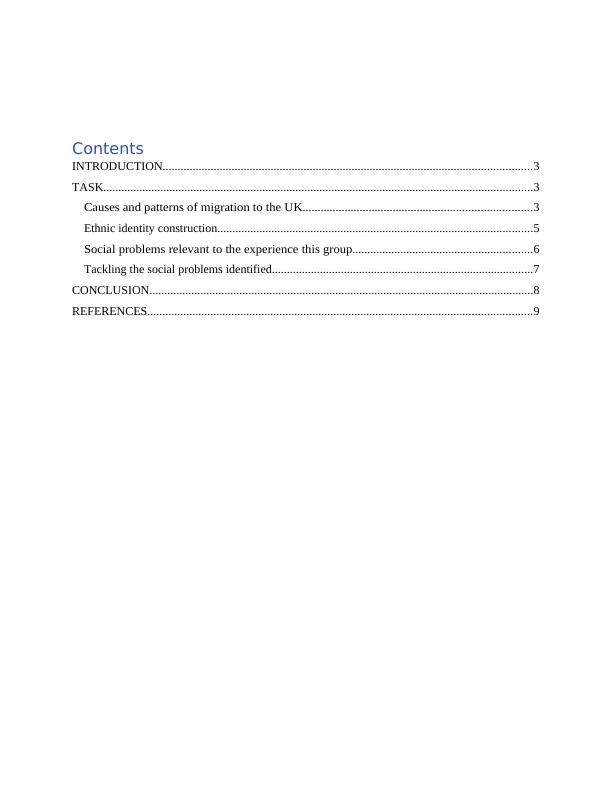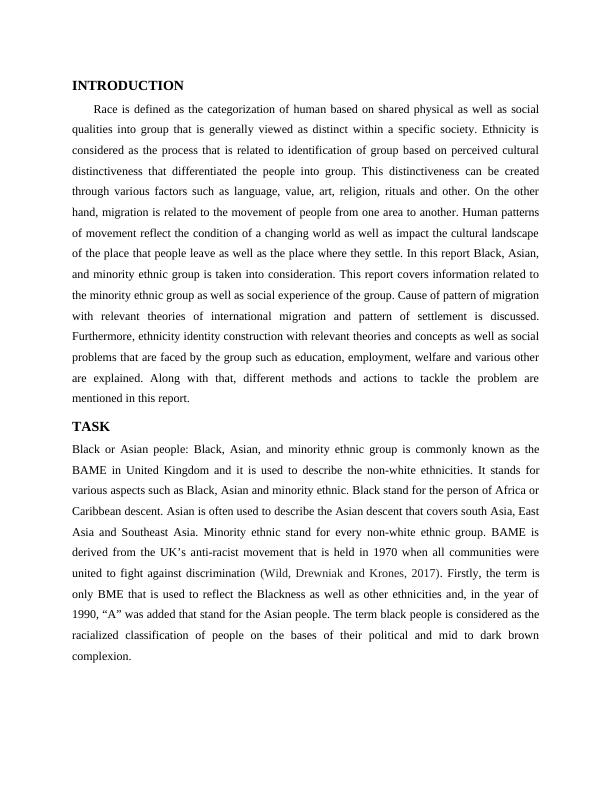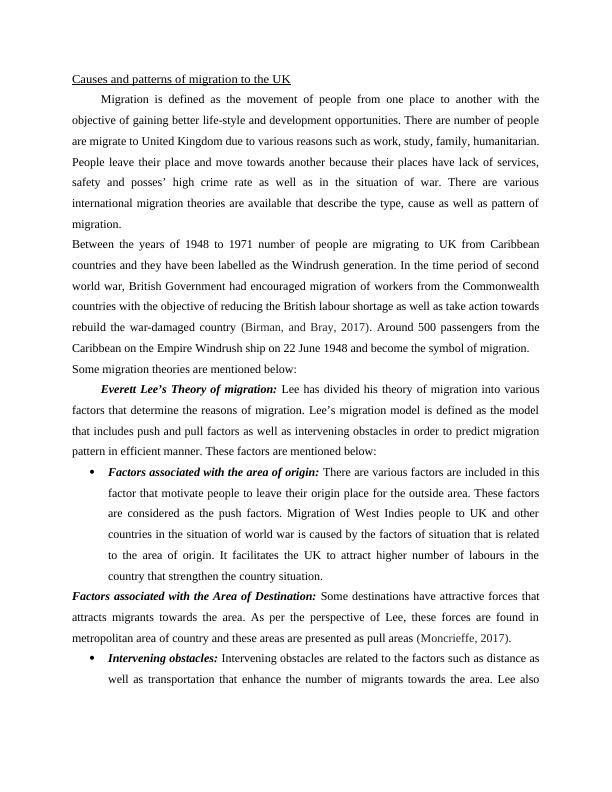Race, Ethnicity & Migration: Causes, Patterns, and Social Problems Faced by BAME Group in the UK
Added on 2023-06-12
11 Pages3181 Words311 Views
Race, ethnicity and
migration
migration

Contents
INTRODUCTION...........................................................................................................................3
TASK...............................................................................................................................................3
Causes and patterns of migration to the UK............................................................................3
Ethnic identity construction.........................................................................................................5
Social problems relevant to the experience this group............................................................6
Tackling the social problems identified.......................................................................................7
CONCLUSION................................................................................................................................8
REFERENCES................................................................................................................................9
INTRODUCTION...........................................................................................................................3
TASK...............................................................................................................................................3
Causes and patterns of migration to the UK............................................................................3
Ethnic identity construction.........................................................................................................5
Social problems relevant to the experience this group............................................................6
Tackling the social problems identified.......................................................................................7
CONCLUSION................................................................................................................................8
REFERENCES................................................................................................................................9

INTRODUCTION
Race is defined as the categorization of human based on shared physical as well as social
qualities into group that is generally viewed as distinct within a specific society. Ethnicity is
considered as the process that is related to identification of group based on perceived cultural
distinctiveness that differentiated the people into group. This distinctiveness can be created
through various factors such as language, value, art, religion, rituals and other. On the other
hand, migration is related to the movement of people from one area to another. Human patterns
of movement reflect the condition of a changing world as well as impact the cultural landscape
of the place that people leave as well as the place where they settle. In this report Black, Asian,
and minority ethnic group is taken into consideration. This report covers information related to
the minority ethnic group as well as social experience of the group. Cause of pattern of migration
with relevant theories of international migration and pattern of settlement is discussed.
Furthermore, ethnicity identity construction with relevant theories and concepts as well as social
problems that are faced by the group such as education, employment, welfare and various other
are explained. Along with that, different methods and actions to tackle the problem are
mentioned in this report.
TASK
Black or Asian people: Black, Asian, and minority ethnic group is commonly known as the
BAME in United Kingdom and it is used to describe the non-white ethnicities. It stands for
various aspects such as Black, Asian and minority ethnic. Black stand for the person of Africa or
Caribbean descent. Asian is often used to describe the Asian descent that covers south Asia, East
Asia and Southeast Asia. Minority ethnic stand for every non-white ethnic group. BAME is
derived from the UK’s anti-racist movement that is held in 1970 when all communities were
united to fight against discrimination (Wild, Drewniak and Krones, 2017). Firstly, the term is
only BME that is used to reflect the Blackness as well as other ethnicities and, in the year of
1990, “A” was added that stand for the Asian people. The term black people is considered as the
racialized classification of people on the bases of their political and mid to dark brown
complexion.
Race is defined as the categorization of human based on shared physical as well as social
qualities into group that is generally viewed as distinct within a specific society. Ethnicity is
considered as the process that is related to identification of group based on perceived cultural
distinctiveness that differentiated the people into group. This distinctiveness can be created
through various factors such as language, value, art, religion, rituals and other. On the other
hand, migration is related to the movement of people from one area to another. Human patterns
of movement reflect the condition of a changing world as well as impact the cultural landscape
of the place that people leave as well as the place where they settle. In this report Black, Asian,
and minority ethnic group is taken into consideration. This report covers information related to
the minority ethnic group as well as social experience of the group. Cause of pattern of migration
with relevant theories of international migration and pattern of settlement is discussed.
Furthermore, ethnicity identity construction with relevant theories and concepts as well as social
problems that are faced by the group such as education, employment, welfare and various other
are explained. Along with that, different methods and actions to tackle the problem are
mentioned in this report.
TASK
Black or Asian people: Black, Asian, and minority ethnic group is commonly known as the
BAME in United Kingdom and it is used to describe the non-white ethnicities. It stands for
various aspects such as Black, Asian and minority ethnic. Black stand for the person of Africa or
Caribbean descent. Asian is often used to describe the Asian descent that covers south Asia, East
Asia and Southeast Asia. Minority ethnic stand for every non-white ethnic group. BAME is
derived from the UK’s anti-racist movement that is held in 1970 when all communities were
united to fight against discrimination (Wild, Drewniak and Krones, 2017). Firstly, the term is
only BME that is used to reflect the Blackness as well as other ethnicities and, in the year of
1990, “A” was added that stand for the Asian people. The term black people is considered as the
racialized classification of people on the bases of their political and mid to dark brown
complexion.

Causes and patterns of migration to the UK
Migration is defined as the movement of people from one place to another with the
objective of gaining better life-style and development opportunities. There are number of people
are migrate to United Kingdom due to various reasons such as work, study, family, humanitarian.
People leave their place and move towards another because their places have lack of services,
safety and posses’ high crime rate as well as in the situation of war. There are various
international migration theories are available that describe the type, cause as well as pattern of
migration.
Between the years of 1948 to 1971 number of people are migrating to UK from Caribbean
countries and they have been labelled as the Windrush generation. In the time period of second
world war, British Government had encouraged migration of workers from the Commonwealth
countries with the objective of reducing the British labour shortage as well as take action towards
rebuild the war-damaged country (Birman, and Bray, 2017). Around 500 passengers from the
Caribbean on the Empire Windrush ship on 22 June 1948 and become the symbol of migration.
Some migration theories are mentioned below:
Everett Lee’s Theory of migration: Lee has divided his theory of migration into various
factors that determine the reasons of migration. Lee’s migration model is defined as the model
that includes push and pull factors as well as intervening obstacles in order to predict migration
pattern in efficient manner. These factors are mentioned below:
Factors associated with the area of origin: There are various factors are included in this
factor that motivate people to leave their origin place for the outside area. These factors
are considered as the push factors. Migration of West Indies people to UK and other
countries in the situation of world war is caused by the factors of situation that is related
to the area of origin. It facilitates the UK to attract higher number of labours in the
country that strengthen the country situation.
Factors associated with the Area of Destination: Some destinations have attractive forces that
attracts migrants towards the area. As per the perspective of Lee, these forces are found in
metropolitan area of country and these areas are presented as pull areas (Moncrieffe, 2017).
Intervening obstacles: Intervening obstacles are related to the factors such as distance as
well as transportation that enhance the number of migrants towards the area. Lee also
Migration is defined as the movement of people from one place to another with the
objective of gaining better life-style and development opportunities. There are number of people
are migrate to United Kingdom due to various reasons such as work, study, family, humanitarian.
People leave their place and move towards another because their places have lack of services,
safety and posses’ high crime rate as well as in the situation of war. There are various
international migration theories are available that describe the type, cause as well as pattern of
migration.
Between the years of 1948 to 1971 number of people are migrating to UK from Caribbean
countries and they have been labelled as the Windrush generation. In the time period of second
world war, British Government had encouraged migration of workers from the Commonwealth
countries with the objective of reducing the British labour shortage as well as take action towards
rebuild the war-damaged country (Birman, and Bray, 2017). Around 500 passengers from the
Caribbean on the Empire Windrush ship on 22 June 1948 and become the symbol of migration.
Some migration theories are mentioned below:
Everett Lee’s Theory of migration: Lee has divided his theory of migration into various
factors that determine the reasons of migration. Lee’s migration model is defined as the model
that includes push and pull factors as well as intervening obstacles in order to predict migration
pattern in efficient manner. These factors are mentioned below:
Factors associated with the area of origin: There are various factors are included in this
factor that motivate people to leave their origin place for the outside area. These factors
are considered as the push factors. Migration of West Indies people to UK and other
countries in the situation of world war is caused by the factors of situation that is related
to the area of origin. It facilitates the UK to attract higher number of labours in the
country that strengthen the country situation.
Factors associated with the Area of Destination: Some destinations have attractive forces that
attracts migrants towards the area. As per the perspective of Lee, these forces are found in
metropolitan area of country and these areas are presented as pull areas (Moncrieffe, 2017).
Intervening obstacles: Intervening obstacles are related to the factors such as distance as
well as transportation that enhance the number of migrants towards the area. Lee also

End of preview
Want to access all the pages? Upload your documents or become a member.
Related Documents
British Bangladeshi Minority Group: Social Experience, Migration, Ethnic Identity, and Social Problemslg...
|8
|2426
|500
Ethnic Minority Discrimination: Concept, Examples, and Impact on Productivitylg...
|5
|1228
|40
Education and Social Justicelg...
|8
|2905
|1
Law and Society: Discrimination Faced by Young Black Menlg...
|7
|1948
|29
Racial Discrimination in UK Housinglg...
|17
|3035
|25
Race Ethnicity & Migration: Causes and Patterns of Migration, Ethnic Identity Construction, Social Problems for Education, and Recommendations for Tackling Social Problemslg...
|12
|3561
|89